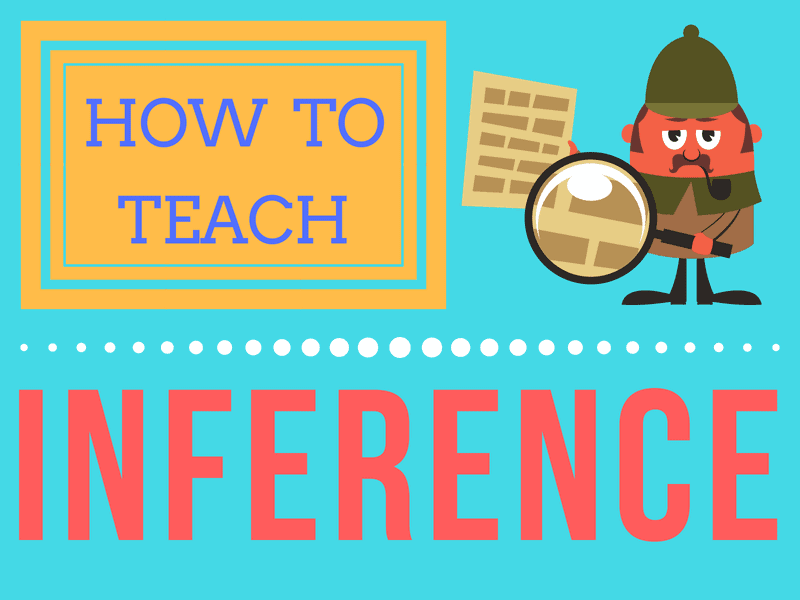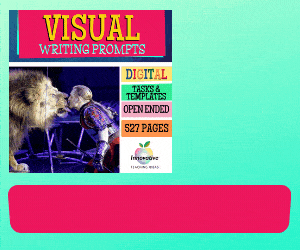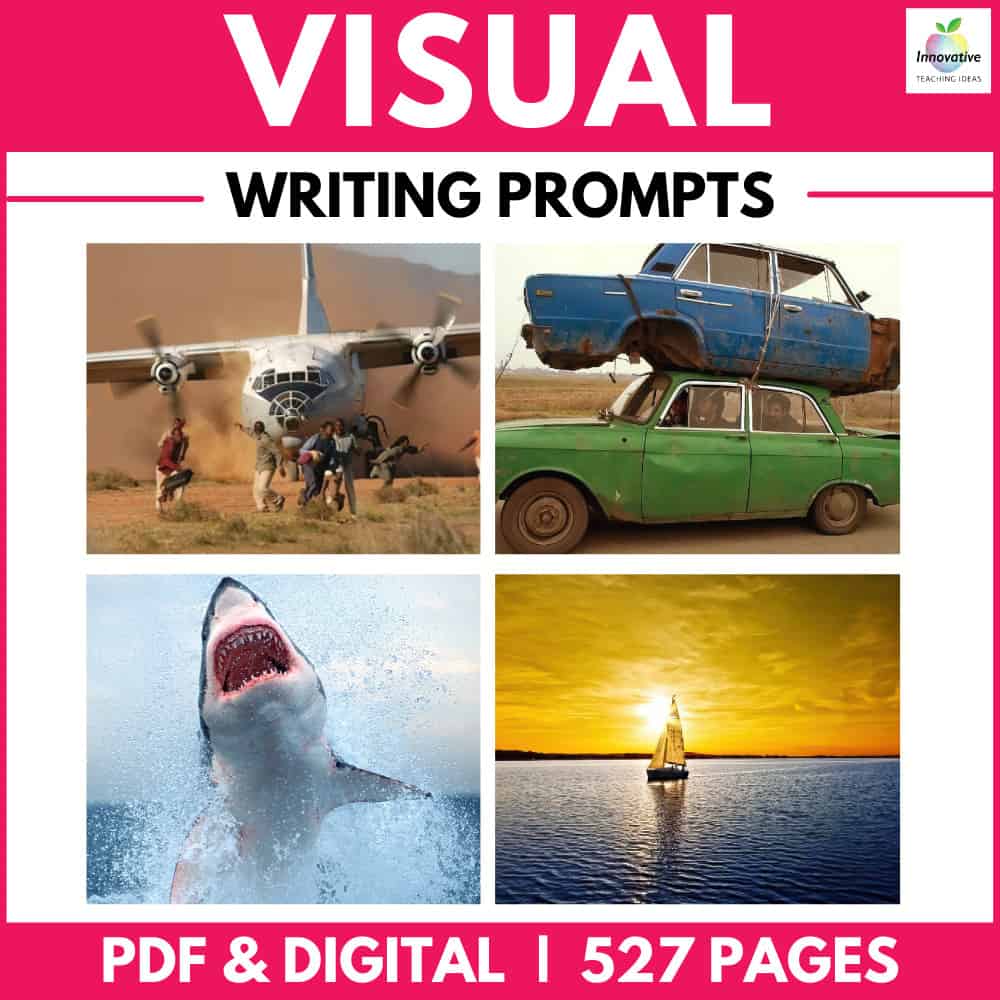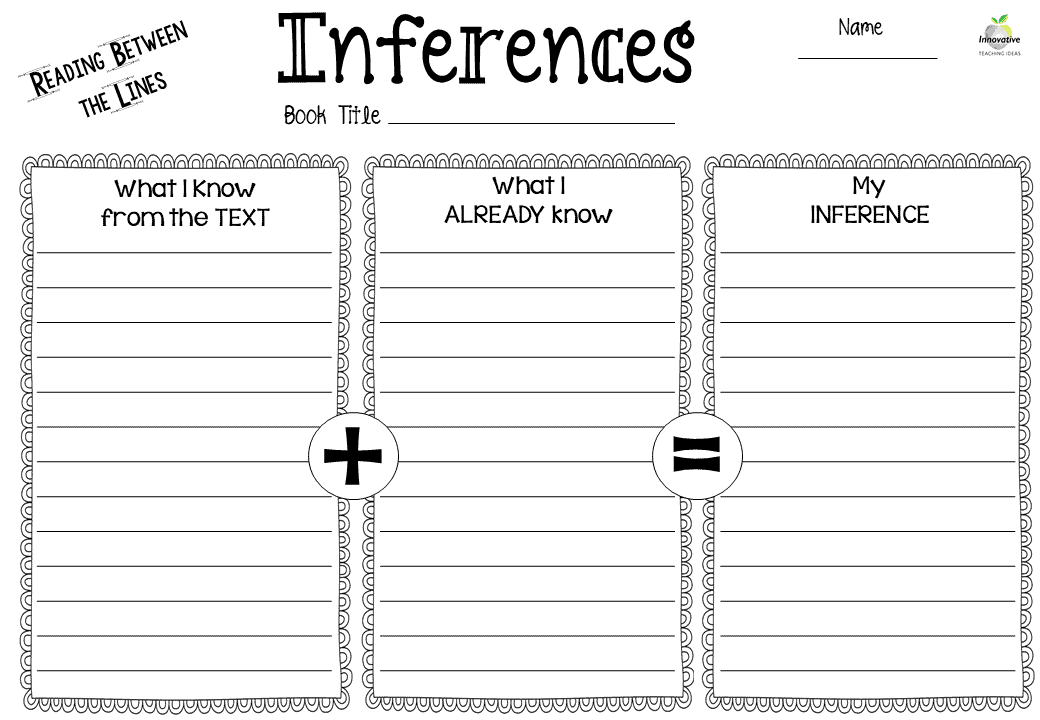Inference Study Guide Reading Questions 4th Grade

WHAT IS AN INFERENCE?


Nosotros've all been there at some bespeak, a blank-faced student stares back at the states in response to our question and states "I don't know, instructor. It doesn't tell us in the story." Unremarkably, this response has been incited by an inferential question, but what exactly is inference?
Inference can exist defined as the process of drawing of a conclusion based on the bachelor prove plus previous knowledge and experience. In teacher-speak, inference questions are the types of questions that involve reading between the lines. Students are required to make an educated guess, as the respond will not be stated explicitly. Students must utilize clues from the text, coupled with their own experiences, to draw a logical conclusion.
Students begin the process of learning to read with simple decoding. From there, they piece of work towards full comprehension of the text past learning to understand what has been said, not but through what is explicitly stated on the page but also through what the writer has unsaid. Information technology is this power to read what has been implied that the term inference refers to. For case, if we come across sentences such equally:
He placed his manus firmly on her back and ushered her hurriedly out the door. "Yes, yes, yes. I volition telephone call you soon to prepare up another meeting. I volition!" George said, punctuating the end of his judgement with a firmly shut door."
In this extract, the author does not explicitly state that the homo in the story wants to get rid of the person he is addressing. He does, all the same, imply this is the case through the activity he describes. Reading this correctly is to infer. To imply is the throw, to infer is the grab.
WHY TEACH INFERENCE?
The teaching of inference skills is extremely of import to our students. Information technology is a higher-order skill that is essential for students to develop to afford them admission to the deepest levels of comprehension. Having a finely tuned ability to infer also has important applications in other bailiwick areas too, peculiarly Math and Scientific discipline. Given the axis of pattern reading in these two subjects, information technology is no surprise that students will find these skills extremely useful when it comes to prediction and evaluation particularly.
Being able to infer from clues develops in our students an appreciation of the importance of basing our opinions on identifiable show. The usefulness of this skill transcends the walls of the classroom. In the world across the schoolhouse gates, the ability to infer will serve students well in their interactions with others on personal, social, and business levels.
Consummate Year LONG INFERENCE WRITING Resource

Tap into the power of imagery in your classroom to get your students to master INFERENCE as AUTHORS and Disquisitional THINKERS.
This Year LONG 500+ Folio unit is packed with powerful opportunities for your students to develop the disquisitional skill of inference through fun imagery and powerful thinking tools and graphic organizers.
HOW IS INFERENCE TAUGHT?
Learning to utilize inference is non easy. For this reason, it is extremely of import to make the process as explicit every bit possible for our students to proceeds a firm grasp of it. I effective means of education inference is to perform a kind of reverse engineering science process. Begin by ensuring the students empathise that:
● Our answers must be supported by clues
● These clues must be added to what we already know
● More one correct answer is possible.
College-level reading comprehension questions oft ask students to depict on their powers of inference, especially in the why and how questions posed, or what questions that are concerned with the student'south ain thoughts and opinion.
Often students infer answers without being aware they are engaged in inference. For this reason, draw attention to how they arrived at their answers. Ask them how they 'inferred' their answer. This volition mean they will take to explain how they arrived at their answer without reference to explicit data in the text. Ask them further questions to prompt how they arrived at their respond. Encourage them to point to the clues and implicit information in the text that led them to their determination. Here, we are working to uncover the mysterious process of inference by shining a light on it.
WHAT'Southward THE DIFFERENCE Between PREDICTING AND INFERRING?
"PREDICTING and INFERRING are frequently confused, but they are non interchangable concepts.
Predicting is the process of asking what might happen side by side based on what we already know from inside and outside the text. Inferring is more a process of enquiring as to what the writer meant?
Predicting focuses more on the WHAT whereas Inferring is more about the WHY"
— LITERACYIDEAS.COM
WHAT TO Practise BEFORE, DURING, AND AFTER READING
INFERRING BEFORE READING
Fine art STYLE What does the cover artwork tell us well-nigh potential characters, setting, genre, audience? What leads us to these conclusions.
TITLE AND TYPOGRAPHY Has the author gone for a whimsical fun title and font manner or a bold, clear style? What might this accept to do with the text? What clues does the text size and style tell us nearly the audition they are targeting?
BLURB what hooks or strategies have been used in the blurb to requite the states some insight into the story. What obvious questions remain unanswered from the blurb? Why might take these decisions been fabricated?
INFERRING DURING READING
Activeness & REACTION If an act or event occurs within the test, note information technology down or accept a shared conversation if reading within a group to decipher your thinking and reaction.
Marking YOUR TEXT Whether you use post-it notes, pencils or otherwise books are meant to be dissected. Apply it equally a physical resource at times to place points to question, claiming and infer over.
LITERAL VS INFERENCE Read a challenging paragraph, and discuss it equally a literal text, and then re-read it as a metaphorical piece. What is the departure? If any, and why?
INFERRING Later on READING
LITERAL VS INFERENCE Read a challenging paragraph, and hash out information technology as a literal text, and and so re-read as a metaphorical piece. What is the deviation? If whatsoever, and why?
PRE-READING REFLECTION Were your expectations met from the pre-reading inference? Do you retrieve this was intended by the author? What impact did this have?
INFERENCE ACTIVITIES FOR TEACHERS AND STUDENTS
Riddles
Setting riddles to solve is an first-class fashion for students to proceeds the necessary practice to hone their skills of inference. The stronger the students are, the more complex the riddle prepare tin can be – this makes for easy differentiation for diverse abilities. Developing this ability to solve riddles requires students to grow in confidence in reading for inference. Riddle-solving tin can be a great introductory activeness on the field of study of inference and can demonstrate to students defective in confidence that they already take some understanding of how the concept works. READ SOME Swell CLASSROOM RIDDLES HERE
Show, Don't Tell
We ofttimes urge our students to "Prove, Don't Tell!" in their writing. Equally their writing skills better we want them to movement abroad from describing the characters in their stories with long lists of adjectives, in favor of revealing their characters through the things they do and say.
To assist students develop their power to read inference, set them the task of identifying a graphic symbol'due south traits in a story exclusively through the things they do and say. This a great reading extension activity that can be easily used as homework besides. Students can work through a story, recording the information in three columns entitled: Character, Trait, Evidence. Remind students they are looking for implicit prove, not things the writer has stated explicitly in the narration.
You can also bridge this reading activeness into writing. Take students write short paragraphs about a personal feel. Tell them not to land whatsoever of the emotions they experienced explicitly. Instead, accept them write details that help the reader sympathize how they felt. Have student volunteers share their writing and briefly discuss each slice. What details helped the reader to understand what the writer was going through? What other details could be added to the writing to enhance this?

Give it to Me Directly! Making inferences Task.
This activeness works well as an extension of the previous exercise and is basically an inversion of Show, Don't Tell! In this exercise, students must accept a few sentences of inference and translate them into explicit statements. The examples of inference identified in the previous activity will serve well as the fabric here. This type of exercise helps students to recognize exactly what is being implied in this frequently very subtle means of advice.
A Picture is Worth a 1000 Words – Visual inference questions
For this activity, popular into the kindergarten library and grab yourself some film books. Ignore the inevitable eye-rolls and moans of derision of the students in forepart of you and explain to them that yous're going to give each of them a book and they are going to 'read' the books to each other.
Children's book illustrators are masters of inference. They tell stories through the skillful use of visual clues. Students must go a translator of these visual clues into words. Encourage stronger students to also translate the inference in the picture into their narration by fugitive explicitly stating things.
You tin also exercise a variation of this task by providing students with captionless photographs or pictures and request them to tell the story of the picture. Students can compare and contrast their inferences for each picture.
Inference in film
Authors accept the luxury of writing endless chapters to paint pictures in our minds and tell a narrative. Flick-makers exercise not have this luxury and are both bound by more than restraints simply given a deeper toolbox to tell a story. If you lot have always listened to a directors commentary whilst watching a film you lot will actually appreciate the attempt a filmmaker goes to use inference in their craft.
Everything included in a film is there for a purpose, the setting, background props, dialogue, music are all calculated decisions used to build emotion and story. Sometimes what is left implied or unshown can as well tell us more what is actually in the film.
Inference and film are a friction match fabricated in heaven in the classroom and volition provide your students with the analytical skills to watch films at a much deeper level.
A Word ON GUIDED READING
Guided reading works extremely well for teaching inference. Working with small groups of students at similar reading levels, y'all can effectively improve their ability to read a text for inference. In your guided reading groups:
● Discuss the importance of the title to the meaning of the text
● Discuss and compare the unlike interpretations of the text past different members of the group and how they arrived at their interpretations
● Discuss the motivations of characters in the stories and the relationships betwixt those characters
● Encourage students to explain how they arrived at their opinion by asking 'How do you lot know?'
● Encourage students to activate prior knowledge through timely discussions.
Be sure to offering opportunities for reading inference across a range of genres. While fictional stories offer the greatest number of opportunities to read for inference, other genres practice offer opportunities too. Expository texts, for instance, promote opportunities for more conscious inference making.
You lot can aid students profoundly by modelling answers yourself and by 'thinking aloud' to show your students how yous arrived at your conclusions. When students are engaged in making their own inferences, encourage them by asking inference-generating questions that will propel them along the path. READ OUR COMPLETE GUIDE TO TEACHING GUIDED READING Here
Make THE IMPLICIT EXPLICIT
The art of inference is a skill, similar most skills, that improves with do. In that location will be aplenty opportunity to reinforce the skills of inference through the form of the average English lesson, as students engage in discussion, complete comprehension exercises, report poetry etc. Even though the skills of inference will be called upon regularly in lessons that are not primarily focused on developing this skill, it is even so important that some discrete lessons are delivered that exercise focus primarily on inference.
Inference is often difficult for students to empathise initially, especially for younger students. It can oftentimes slip just across their grasp due to its subtle nature. Brainstorm with baby steps. Try to climb downwards the ladder of abstraction and peel back the layers to make the implicit explicit. With practice, students will soon exist able to move beyond recognizing and reading inference in the works of others to contain it into their own piece of work.

USEFUL VIDEO FOR Instruction INFERENCE
Content for this page has been written past Shane Mac Donnchaidh. A former primary of an international school and university English lecturer with 15 years of teaching and assistants experience. Shane's latest Volume the Consummate Guide to Nonfiction Writing can exist found here. Editing and support for this article have been provided by the literacyideas team.
Source: https://literacyideas.com/teaching-inference/
0 Response to "Inference Study Guide Reading Questions 4th Grade"
Postar um comentário